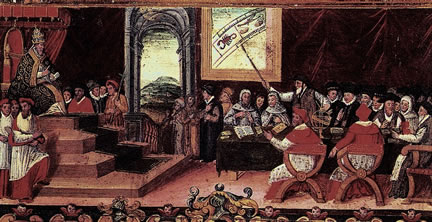The Gregorian calendar

The year 708 ab Urbe condita was established by Julio César ultimus annus confusionis and had the duration of 445 days to be able to re-align the duration of the calendar year with the solar year; 45 BC was the first year in which the passage of days and seasons was characterized according to the Julian calendar.
In the new calendar there was a small error: the solar calendar was shorter than 11 minutes each year, but the difference had no important consequences for the flow of civilian life, although it was added more than a whole day in 128 years.
It was at the end of the sixteenth century that the breach began to produce important effects for the Church of Rome.
In the year 325 the Council of Nicaea had established the rules for calculating on what day the Easter had to fall. Easter is a holiday whose date is calculated in relation to the lunar cycle, ie Easter must fall on the Sunday following the first full moon of spring; at the time of the Council of Nicaea the equinox was March 21, and so this was the date set for reference.
The Roman church to comply with this rule had always supported and encouraged scholars of astronomy and so in the sixteenth century it became clear to astronomers that the Julian calendar, still in force and in which the rule was formulated, did not allow it respect of the same rule, in other words contained an error of 11 minutes each year.
In 1582, during the pontificate of Gregory XIII, this error had led to a difference of 10 days between the virtual day of the calendar and the actual day of the spring equinox, and thus continuing Easter would been celebrated in summer.
The Pope entrusted to a group of experts the task of solving the problem; under the direction of Jesuit mathematician Christopher Clavius worked the doctor Aloysius Lilius, the mathematician and astronomer Joseph Scala and the mathematician Ignatius Danti, they used measurements of the tropical year (solar) and the sidereal year (lunar) made by Nicolaus Copernicus.
The new standard changes the average duration of the year by changing the method of calculating the leap years: the leap years fall every 4 years, but with a condition that the years whose number is a multiple of 100, as saying that multiples of 100 are leap only if the numbering is also a multiple of 400: come to say that they are leap years 1600 - 2000 and 2400, but they are not leap years 1900 - 2100 to 2200.
The rule does not completely solve the problem because it always has an error of about 6 more seconds each year, but you can not have a perfect calendar because they affect other phenomena on the basis of calculation. For example, due to tidal phenomena, the earth's rotation is slowing down, so we have a longer day and then, to keep the civil day, aligned with the astronomical, for a few decades a second is added whenever necessary ...
Sign up and read the rest of the article!
by M.L. ©ALL RIGHTS RESERVED (Ed 1.0 - 16/03/2017)






